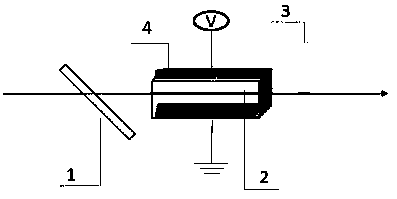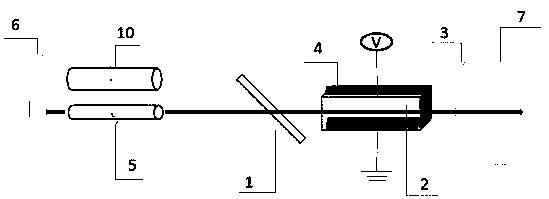A low voltage driven electro-optic Q-switching switch based on tetragonal potassium tantalum niobate crystal
A technology of potassium tantalum niobate and tetragonal phase is applied in the field of low-voltage driving electro-optical Q-switching devices, which can solve problems such as no practical value, and achieve the effects of compact structure, stable structure and simple design.
- Summary
- Abstract
- Description
- Claims
- Application Information
AI Technical Summary
Problems solved by technology
Method used
Image
Examples
Embodiment 1
[0025] Embodiment 1: An electro-optic switch driven by low voltage based on tetragonal phase potassium tantalum niobate. An electro-optic switch, the structure is as follows figure 1 As shown, 1 is a polarizer, 2 is a KTN crystal device with a metal film plated on the surface, and 3 is a quarter-wave plate and a metal layer electrode 4 on the surface of the KTN crystal. Polarizer 1 is a device for generating polarization and detection. The optical axis of quarter-wave plate 3 is at a 45-degree angle to the polarization direction of the laser light passing through the potassium tantalum niobate (KTN) crystal device. The quarter-wave plate is used The phase difference between ordinary light and extraordinary light produced by the laser wavelength is π / 2. The light-transmitting surface of the KTN crystal device 2 coated with a metal film on the surface is a square whose sides are parallel to the X and Y axes of the potassium tantalum niobate (KTN) crystal, with a side length of 3...
Embodiment 2
[0026] Embodiment 2: As described in Embodiment 1, the difference is that the light-transmitting surface of the KTN crystal device 2 coated with a metal film on the surface is a square whose sides are parallel to the X and Y axes of the potassium tantalum niobate (KTN) crystal, The side length is 3 mm, the light transmission direction is along the Z-axis of the potassium tantalum niobate (KTN) crystal, and the length is 6 mm.
Embodiment 3
[0027] Embodiment 3: As described in Embodiment 1, the difference is that the light-transmitting surface of the KTN crystal device 2 coated with a metal film on the surface is a square whose sides are parallel to the X and Y axes of the potassium tantalum niobate (KTN) crystal, The side length is 3 mm, the light transmission direction is along the Z-axis of the potassium tantalum niobate (KTN) crystal, and the length is 9 mm.
PUM
 Login to View More
Login to View More Abstract
Description
Claims
Application Information
 Login to View More
Login to View More - R&D
- Intellectual Property
- Life Sciences
- Materials
- Tech Scout
- Unparalleled Data Quality
- Higher Quality Content
- 60% Fewer Hallucinations
Browse by: Latest US Patents, China's latest patents, Technical Efficacy Thesaurus, Application Domain, Technology Topic, Popular Technical Reports.
© 2025 PatSnap. All rights reserved.Legal|Privacy policy|Modern Slavery Act Transparency Statement|Sitemap|About US| Contact US: help@patsnap.com



